At this point some of you may be wondering what it is exactly that makes the process of captive chimpanzee group formation so difficult, so I thought we could take a step back and look at some of the challenges.
It starts with biology. Free-living chimpanzees live in large communities ranging from just over a dozen to nearly two hundred individuals. The dynamic structure of these communities, a system known as fission-fusion, allows for regular changes in group size and composition in response to factors such as the abundance of food or the presence of females in estrus. This form of social organization enables chimpanzee communities to adapt to variations in resource availability by temporarily splitting into smaller parties while retaining the protection and other benefits of living in a large group.

But while subgroups are free to split off from and later rejoin the community, only certain individuals are generally allowed to leave their community entirely to join another. To do this successfully, it helps to be young and female.
Chimpanzee communities as a whole are understandably protective of what is most important to their survival and reproductive success; namely, access to food and potential mates. Neighboring communities threaten to compete for these scarce resources, which is why chimpanzees often exhibit such fierce territoriality. Groups of males, and in rare cases both males and females, will coordinate patrols of their territorial boundaries and attack, often lethally, lone individuals or small groups from neighboring communities that have wandered too close.

As Anthony mentioned previously, males remain in their natal groups for life and form lifelong bonds with one another. Consequently, there is no biological or cultural mechanism to facilitate the transfer of males from one community to another. Nor is there a straightforward path for adult females to transfer. But as adolescent females reach sexual maturity, they generally leave their natal communities and seek out new one. This instinctual emigration is assumed to be an evolved mechanism to prevent inbreeding within the community and the timing of their departure is anything but arbitrary. While fear of outsiders remains the general rule, males are typically welcoming of young immigrant females, especially ones who arrive with estrus swellings. Resident females are not always as welcoming to the newcomers who, bear in mind, will be eating from the same fruit trees and potentially competing for the attention of resident males, but the newcomers can rely on protection from the resident males as they assimilate into the new community.
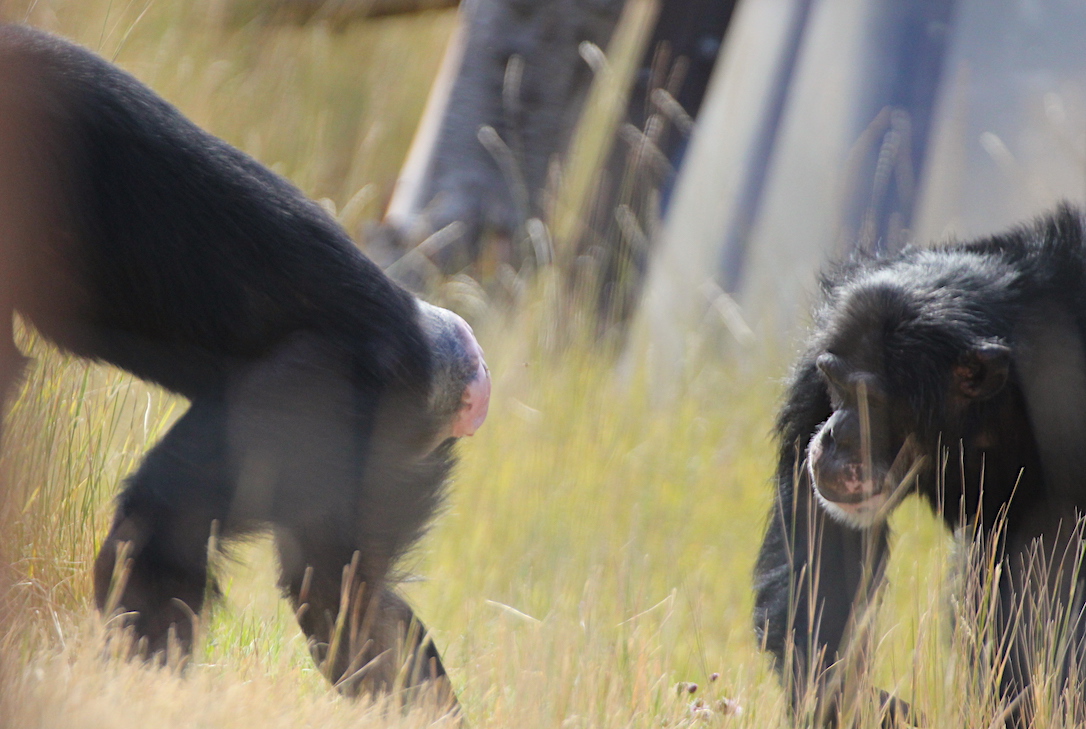
So there is a clear pattern, with limited exceptions, across nearly all chimpanzee communities in Africa: There is only one reliable ticket to move between communities, and it is determined by the immutable characteristics of age and sex and to a large extent reliant on the selfish desires of the males who hold power. When we form groups in captivity, we are almost always fighting against millions of years of natural history.
Of course, chimpanzees are not products of instinct alone, but beneath the layers of culture there remain a number of instinctual tendencies that stand out in the captive environment. An example: When captive chimpanzees go to bed at night, they typically make nests just like their wild cousins. These nests may be made out of straw, wood wool, or blankets instead of branches, but they generally share one trait in particular with those of their wild counterparts: they have high sides to hold them in. For wild chimpanzees, the nest serves as a cradle to keep them from plunging dozens of feet to the ground while they slumber. Perhaps it would only make sense for captive chimpanzees to do the same, except that they create the same doughnut-shaped nests even when sleeping in the middle of a concrete floor. In fact, sometimes they sleep directly on the concrete with all of the blankets arranged into a ring around them. It’s a bit of security-seeking encoded in the biology of a species far removed from the environment in which they evolved. Instincts can be attenuated by both learning and the environment but they remain a powerful driving force in our behavior.
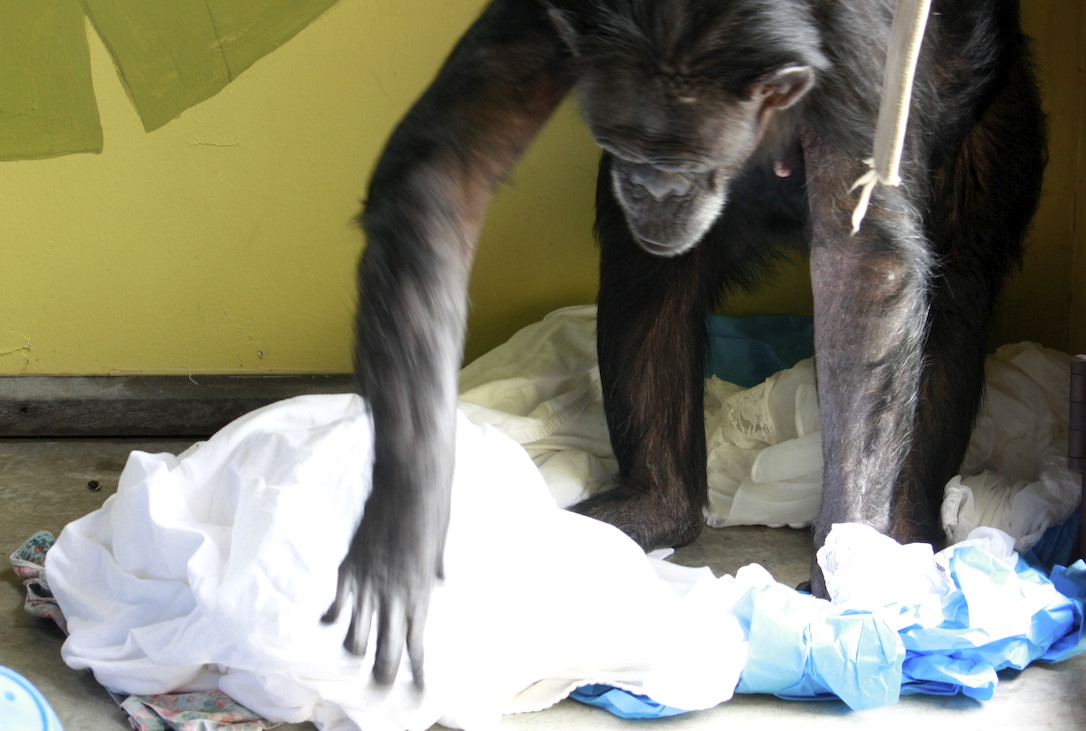
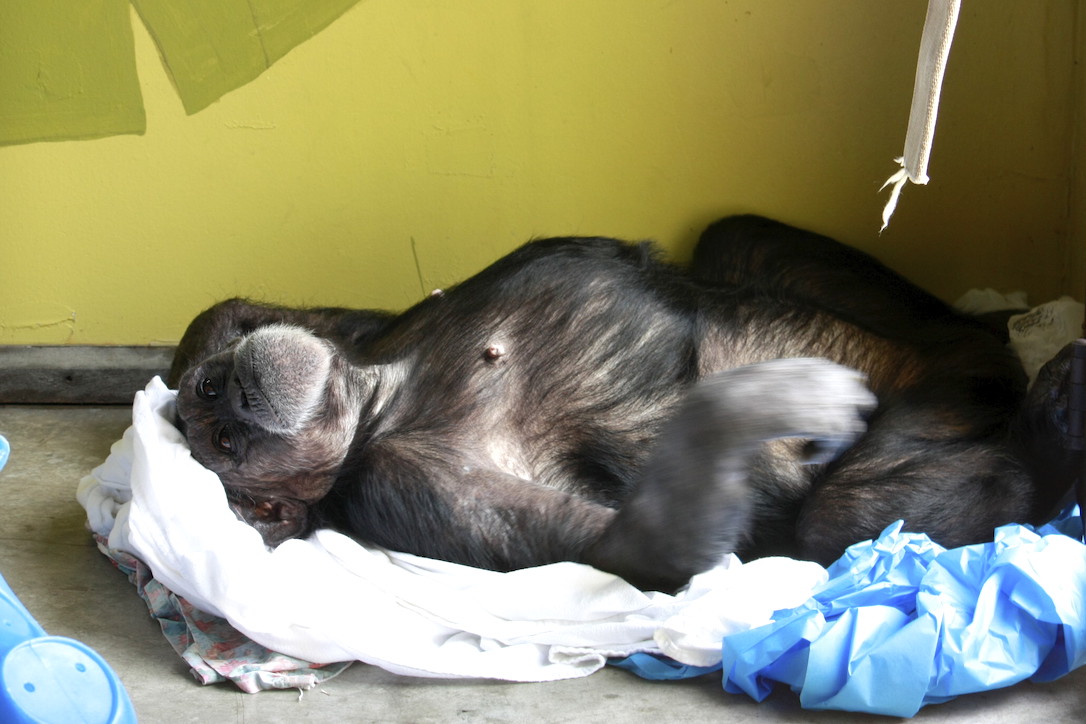
To some extent, the nurture side of the nature-nurture influence probably does mitigate some of these xenophobic tendencies. Lab-reared chimpanzees are regularly moved between pairs or small groups throughout their lives, and they do not grow up in a culture that systematically reinforces their biological predispositions towards outsiders as their wild counterparts do. In a way, captive-born chimpanzees are trained to ignore their biology. Sadly, their upbringing presents its own set of problems.
Maintaining peace and order in a chimpanzee community requires strict adherence to certain social norms and conventions. If you watch the video of Burrito and Willy B meeting alone for the first time, you can see the delicate communication required to navigate such a perilous moment. To facilitate the encounter, Willy B covers his top teeth with his upper lip and shows only his lower ones. This signals an intent not to harm – specifically, not to bite – much in the same way that a dog’s bow signals an intent to play. At the same time, he engages in vigorous “breathy panting,” a vocalization that conveys friendliness and interest. He senses Burrito’s fear and as a result he gives Burrito a wide berth. Burrito, for his part, conveys to Willy B that despite his fear he would like to get closer by extending an arm toward him. One misstep by either party and the entire process could unravel into outright aggression, as it did during their group encounter two weeks prior.
And while they overcame the risks of this initial encounter, the challenge of actually living together has, unfortunately, only begun. Sustaining friendships and alliances is difficult and constant work, and studies show that chimpanzees separated from their mothers at an early age and raised by humans exhibit social deficiencies that make group living harder as adults. These chimpanzees fail to develop the knowledge and skills required to navigate the complex and often subtle rules of chimpanzee social life. As a result, they are more likely to have to live in small groups or in some cases, alone.
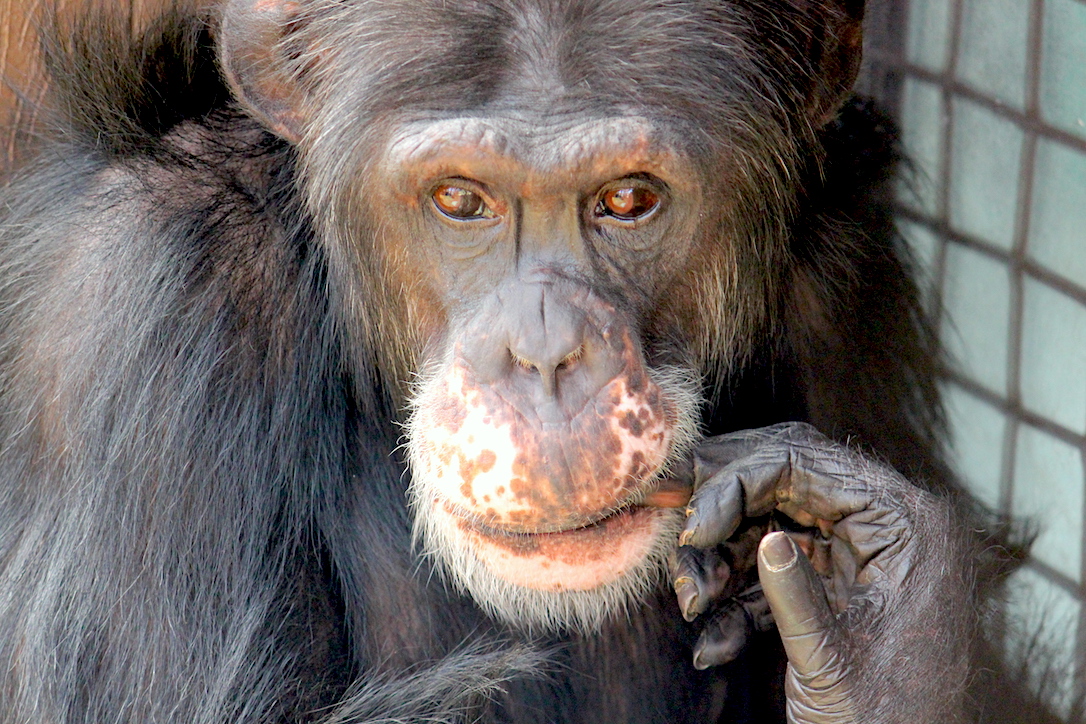
Despite all of this, most chimpanzees in sanctuaries, zoos, and laboratories can and do live in groups. As they should, because the benefits of a large social network are immeasurable. But we need to keep in mind what we are asking of them: to plunge ahead, ill-equipped and unprepared, and with almost no control at all, into a process that goes against their very instincts. This is one of the many sad realities of captivity for chimpanzees.
So despite our setback with the group of ten, I am, at the moment, hopeful. Burrito and Willy B have been living together since Wednesday, grooming regularly and playing with one another on occasion. These two guys overcame their fears and are experiencing the initial whispers of a bond that should have been their birthright as male chimpanzees. Whether it will be sustained over time, and amidst the turbulent influence of other group members, remains to be seen. But it’s a promising start.
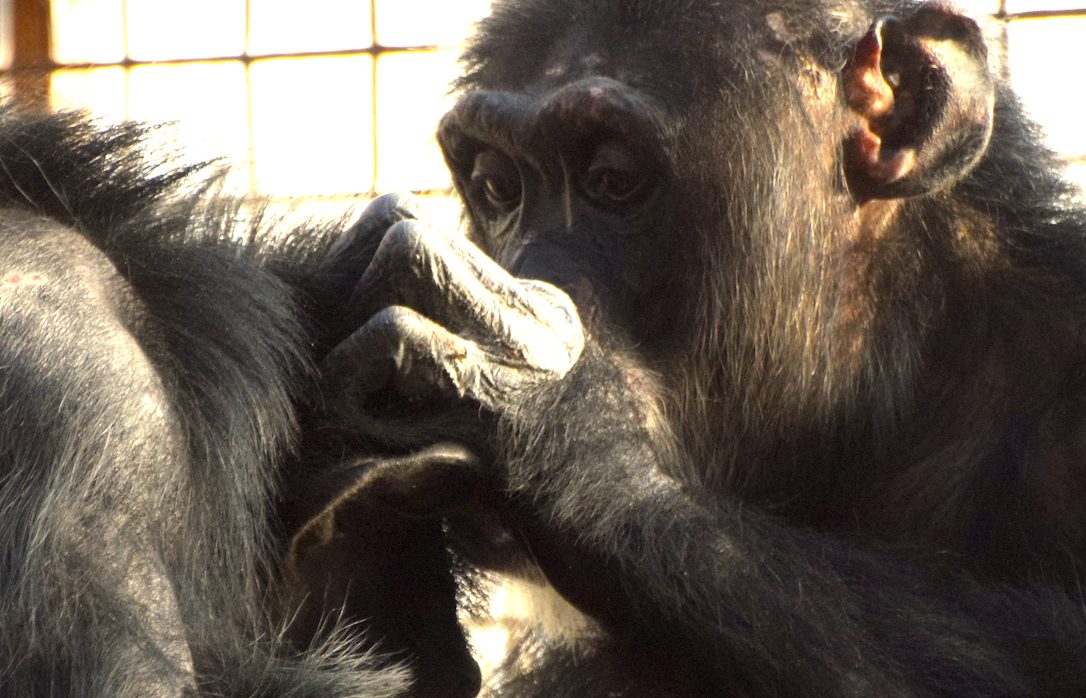





How fascinating. I now understand so much better what a task it is to integrate these chimpanzees. So glad that Burrito and Willy B are navigating well so far. Hope they continue and that the rest can come together. So glad you, JB, and the staff, have the knowledge and the patience and the love for all of them.
Great explanation and background/overview information .. Thank you J.B. They are all incredible beings… as are you all who have made this possible for them. We are all hoping for the best – they could not have a better team to shepherd their blossoming friendships… with the bumps and bruises along the way.. it takes great courage on everyone’s part! Anxiously waiting every day for the posts.
Thank you. This was very interesting and helpful.
Wonderful thoughtful post and thank you J.B.!! Bravo to you all for bravery, patience and using your intuition to navigate these waters!! Hugs and love to you all…
Fascinating. Thank you for such a thoughtful explanation. Such a complex dance. Hopeful that all works out finally. Thanks for sharing this process with us.
Great post. Thank you for the interesting information.
Thank you J.B.. I didn’t realize that Burrito and Willy B were actually living together and instead assumed they were being separated and then joined together on and off. I hope their inner instincts shine through so the two boys can become life long companions. Perhaps Burrito will have a lot to learn from Willy B (and visa versa). Wishing you continued good luck.
I think they still are, Kathleen.
Btw, will this one work? Looks like you should be able to squeeze treats in there.
https://www.indestructibledog.com/collections/dog-balls/products/dogify-indestructible-bowling-ball?variant=30818988557
Ha haa, you are so sweet Linda. Yes, we do use these too but the balls with a lot holes were the bomb. Thanks!
J.B…It’s times like todays blog, when I must force myself to read a bit more slowly (at least during the first or second readings of the text) because I find your observations & tremendous knowledge about Chimpanzees, (wild & captive), so incredibly fascinating, that I zoom through every word, (not wanting it to end) & then I end up admonishing I myself for not reading more slowly & savoring every single sentence…I can’t seem to ever get enough..
Fantastic job J.B. of painting a clear picture of how it works in the wild, the challenges of captivity, and the amazing process and progress going on there. Staying hopeful…
Thank you for sharing this information it helps to understand the challenges for all of you!
Thank you for such a thorough explanation. The Chimp people at your sanctuary continue to be an inspiration to me. Despite all the adversity and cruelty they faced in their collective pasts, their rise above their fears and uncertainty and come out the other side, sometimes a little worse for the wear, but triumphant. Respect.
Thank you, J.B.
So our goofy guy may always be the “odd man out”…..I just hope eventually he can be in some kind of group.
Willy B, I think I said the other day, does indeed have a great play face, rivaled only by Jo’s, and from the video it looks like he makes a ridiculous amount of noise while grooming (or was that exaggerated for meeting Burrito, because until now we’ve only seen him being groomed).
Funny that Mave and Willy appear to have a higher level of social intelligence, while Honey B is not the best at reading those cues, either. Almost as though she were a youngster, but she’s their age, and was released young, as they were. But thank God for their social navigation skills!
I know it’s way off yet, but if and when these guys form one group, what do you anticipate is pecking order when it comes to food? (I’m thinking of Willy and Jamie who steals and “never gives anything back”). In the days that the girl gang was with Willy and Mave, were there fewer fights?
It’s hard to say. Willy B loves his food. Perhaps even more than Burrito, though he doesn’t squeak as much. And his size combined with his enthusiasm certainly intimidates the girls – even Mave. So meal time will likely revolve around him, however the groups end up.
There was plenty of tension when the girls were with Willy B, Mave, and Honey B…mostly due to Honey B. She is full of sass, and she was regularly testing how far she could push Annie and the others while relying on protection from Willy B and Mave. This will continue to be a challenge as we build the group back up. But these were mostly screaming matches with no injuries.
J.B., I commend you for yet another elucidating post on the behavior of the chimpanzees. I, too, have wondered (and worried) about the politics of feeding time now that there are three more mouths to feed at the sanctuary. I am pleased, however, to learn that Burrito appears to have healed to the extent that he and Willy B are sharing living quarters.
Thanks, JB. I noticed you said in another post how excited Jo was to sit Next to the Big man (and man, did her face show it), but he was more focused on food….I wonder if The Boss will try to keep stealing, now that she won’t be the biggest bully on the block.
Cheers!
What a complicated set of rules and regulations. It is great that such a knowledgeable person is running the sanctuary or there would be more injuries. Thanks, JB for sharing your vast knowledge on the topic with all of us who daily look into your lives.
Really interesting! Thank you for taking the time to explain this. I’m curious – do you know if gorillas operate in the same way or are their social structures different?
I believe there are some similarities – females do typically emigrate from their natal groups – but because of the dominant silverback structure of gorilla social groups the males often disperse as well to form their own groups. There are also differences between eastern lowland, western lowland, and mountain gorilla social systems: http://pin.primate.wisc.edu/factsheets/entry/gorilla/behav
Did the original 7 mesh well the second they came off the truck? Or did you have to go through this process 10+ yrs ago, as well?
So funny that Jamie and Burrito had the same beginning life experiences, but Jamie seems to have picked up chimp skills along the way, even if she considers herself different
The original seven had lived together as a group for about two years prior to coming to the sanctuary, so all we had to do is reunite them after their separation for transport. But the lab obviously had to put them together, and judging from the missing ears, toes, and fingers, I’d guess it took a while to get settled as a group (and as you know they never completely settled).
Jamie’s chimps skills are OK, but you can tell she was human-reared. The biggest difference between her and Burrito is confidence.
Thanks for the informative and thoughtful post J.B. It illuminates for us, just how complicated this process actually is. Something we could never know from the outside.
I wasn’t aware that anyone was missing toes and fingers. Ouch! I would be interested in knowing who.
Hi Marcia: When the chimps arrived, Burrito was missing a fingertip and most of one ear, Negra was missing one ear, Missy was missing a fingertip, and Jody was missing a toe. Jody was also missing an additional three toes because a guillotine door in the lab was slammed on her foot and they had to be amputated.
Wow, that was an enlightening read. It makes me wonder if you’re creating small groups like the boys and then eventually bring them together as one? Looking at Burritos pic is mesmerizing! His hands look almost human. It’s amazing how much like us they are. I hope the boys continue to thrive together. What a difficult and heartwrenching process this must be.
Hi Sandra: We’re taking things one step at a time, but tentatively our plan is to leave the boys together and slowly add others, two at a time. At this point, Burrito still needs to meet Mave and Honey B again and Foxie needs to meet all three of the newcomers again, so we will likely try to arrange some time for a few one-on-ones. But the way the chimps react to each step tells us how successful our strategy is, and more than likely we will have to adjust on the fly.